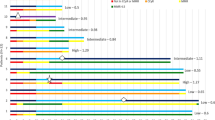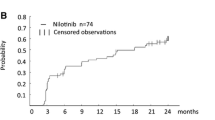Abstract
The aim of this phase IV study was to (1) to define efficacy of escalating dose imatinib in chronic myeloid leukemia (CML) patients showing suboptimal response to standard dose imatinib and (2) to find markers that predict the response to escalating doses of imatinib. CML patients in chronic phase (CP) who failed to achieve optimal response with 400 mg/day imatinib or patients in accelerated phase (AP) or blast crisis (BC) who failed to achieve complete hematologic response after 3 months of 400–600 mg/day imatinib were enrolled. CP patients received 600 mg/day, while AP/BC patients received 600–800 mg/day imatinib. Patients received imatinib for at least 12 months or until the disease progression or intolerable toxicity. Along with cytogenetic response (CyR), molecular response was assessed with BCR-ABL/ABL ratio. Baseline BCR-ABL gene mutation test was performed. Seventy-one patients (median age, 49.0 years, M:F = 50:21) received escalated dose imatinib. Grade 3 edema in two patients was the only nonhematologic toxicities more than grade 2. For evaluable patients, 30.8% of patients achieved CCyR at 6 months, and median time to treatment failure (TTFx) was 18.0 months. TTFx was longer in patients who achieved greater than 50% reduction in BCR-ABL/ABL within 6 months (early molecular responder (EMR)) compared with those who did not (non-EMR; p < 0.001). Of 31 patients who had mutational status data, three had mutation. All mutants failed to achieve CCyR. In conclusion, escalated dose imatinib shows considerable efficacy with tolerable toxicity in CML patients showing suboptimal response to standard dose imatinib. EMR is an early predictive marker for positive imatinib response.

Similar content being viewed by others
References
Baccarani M, Saglio G, Goldman J et al (2006) Evolving concepts in the management of chronic myeloid leukemia: recommendations from an expert panel on behalf of the European LeukemiaNet. Blood 108:1809–1820
Hughes T (2006) ABL kinase inhibitor therapy for CML: baseline assessments and response monitoring. Hematology Am Soc Hematol Educ Program 211–218
Hochhaus A, Hughes T (2004) Clinical resistance to imatinib: mechanisms and implications. Hematol Oncol Clin North Am 18:641–656, ix
Druker BJ, Guilhot F, O’Brien SG et al (2006) Five-year follow-up of patients receiving imatinib for chronic myeloid leukemia. N Engl J Med 355:2408–2417
Chu S, Xu H, Shah NP et al (2005) Detection of BCR-ABL kinase mutations in CD34+ cells from chronic myelogenous leukemia patients in complete cytogenetic remission on imatinib mesylate treatment. Blood 105:2093–2098
Corbin AS, La Rosee P, Stoffregen EP et al (2003) Several Bcr-Abl kinase domain mutants associated with imatinib mesylate resistance remain sensitive to imatinib. Blood 101:4611–4614
Morel F, Bris MJ, Herry A et al (2003) Double minutes containing amplified bcr-abl fusion gene in a case of chronic myeloid leukemia treated by imatinib. Eur J Haematol 70:235–239
Azam M, Latek RR, Daley GQ (2003) Mechanisms of autoinhibition and STI-571/imatinib resistance revealed by mutagenesis of BCR-ABL. Cell 112:831–843
Kantarjian HM, Talpaz M, O’Brien S et al (2003) Dose escalation of imatinib mesylate can overcome resistance to standard-dose therapy in patients with chronic myelogenous leukemia. Blood 101:473–475
Kantarjian H, Pasquini R, Hamerschlak N et al (2007) Dasatinib or high-dose imatinib for chronic-phase chronic myeloid leukemia after failure of first-line imatinib: a randomized phase 2 trial. Blood 109:5143–5150
Jabbour E, Cortes JE, Kantarjian HM (2009) Suboptimal response to or failure of imatinib treatment for chronic myeloid leukemia: what is the optimal strategy? Mayo Clin Proc 84:161–169
Hughes TP, Kaeda J, Branford S et al (2003) Frequency of major molecular responses to imatinib or interferon alfa plus cytarabine in newly diagnosed chronic myeloid leukemia. N Engl J Med 349:1423–1432
Hughes T, Branford S (2006) Molecular monitoring of BCR-ABL as a guide to clinical management in chronic myeloid leukaemia. Blood Rev 20:29–41
Cortes J, Talpaz M, O’Brien S et al (2005) Molecular responses in patients with chronic myelogenous leukemia in chronic phase treated with imatinib mesylate. Clin Cancer Res 11:3425–3432
Kantarjian HM, Giles F, Gattermann N et al (2007) Nilotinib (formerly AMN107), a highly selective BCR-ABL tyrosine kinase inhibitor, is effective in patients with Philadelphia chromosome-positive chronic myelogenous leukemia in chronic phase following imatinib resistance and intolerance. Blood 110:3540–3546
Kantarjian H, Giles F, Wunderle L et al (2006) Nilotinib in imatinib-resistant CML and Philadelphia chromosome-positive ALL. N Engl J Med 354:2542–2551
Talpaz M, Shah NP, Kantarjian H et al (2006) Dasatinib in imatinib-resistant Philadelphia chromosome-positive leukemias. N Engl J Med 354:2531–2541
Kantarjian H, Pasquini R, Levy V et al (2009) Dasatinib or high-dose imatinib for chronic-phase chronic myeloid leukemia resistant to imatinib at a dose of 400 to 600 milligrams daily: two-year follow-up of a randomized phase 2 study (START-R). Cancer 115:4136–4147
Kantarjian HM, Larson RA, Guilhot F et al (2009) Efficacy of imatinib dose escalation in patients with chronic myeloid leukemia in chronic phase. Cancer 115:551–560
Alvarado Y, Kantarjian H, O’Brien S et al (2009) Significance of suboptimal response to imatinib, as defined by the European LeukemiaNet, in the long-term outcome of patients with early chronic myeloid leukemia in chronic phase. Cancer 115:3709–3718
Soverini S, Colarossi S, Gnani A et al (2006) Contribution of ABL kinase domain mutations to imatinib resistance in different subsets of Philadelphia-positive patients: by the GIMEMA Working Party on Chronic Myeloid Leukemia. Clin Cancer Res 12:7374–7379
Kantarjian HM, Talpaz M, Giles F et al (2006) New insights into the pathophysiology of chronic myeloid leukemia and imatinib resistance. Ann Intern Med 145:913–923
Jabbour E, Kantarjian HM, Jones D et al (2008) Characteristics and outcome of chronic myeloid leukemia patients with F317L BCR-ABL kinase domain mutation after therapy with tyrosine kinase inhibitors. Blood 112:4839–4842
Acknowledgement
This work was supported by a grant from the Korea Health 21 R&D Project, Ministry of Health & Welfare, Republic of Korea (0405-BC02-0604-0004).
Author information
Authors and Affiliations
Consortia
Corresponding author
Additional information
The Korean Society of Hematology CML working party investigators are listed in the Appendix.
Appendix
Appendix
The investigators for the Korean Society of Hematology CML Working Party were as follows: President: Seonyang Park; Secretary: Inho Kim; Sung-Soo Yoon, Hyeoung-Joon Kim, Sang Kyun Sohn, Jooseop Chung, Ho-Jin Shin, Chul Soo Kim, Min Kyoung Kim, Chul Won Jung, Byung-Soo Kim, Yu-Kyung Kim, Jae Seog Kim, Jin Seog Kim, Jae-Yong Kwak, Na-Ri Lee, Yoo-Hong Min, Chong Won Park, Suk Joong Oh, Jung-Hee Lee, Dae Young Zang, Jun-Won Cheong, Deog-Yeon Jo, Bong Seog Kim, Sun-Hee Kim, Hun-Mo Ryu, Seung-Hyun Nam, Yeung-Chul Moon, Kyung-Tae Park, Mu-Rim Park, Eunkyung Park, Jae-Hoo Park, Chi-Hyung Park, Soo-Mee Bang, Sung-Hwa Bae, Moon-Hee Lee, Sung-Soo Jang, Jun-ho Jang, Choon-Hae Chung, Hyun-Sook Chi, Sam-Im Choi, and Jung-Lim Lee.
Rights and permissions
About this article
Cite this article
Koh, Y., Kim, I., Yoon, SS. et al. Phase IV study evaluating efficacy of escalated dose of imatinib in chronic myeloid leukemia patients showing suboptimal response to standard dose imatinib. Ann Hematol 89, 725–731 (2010). https://doi.org/10.1007/s00277-010-0910-8
Received:
Accepted:
Published:
Issue Date:
DOI: https://doi.org/10.1007/s00277-010-0910-8




